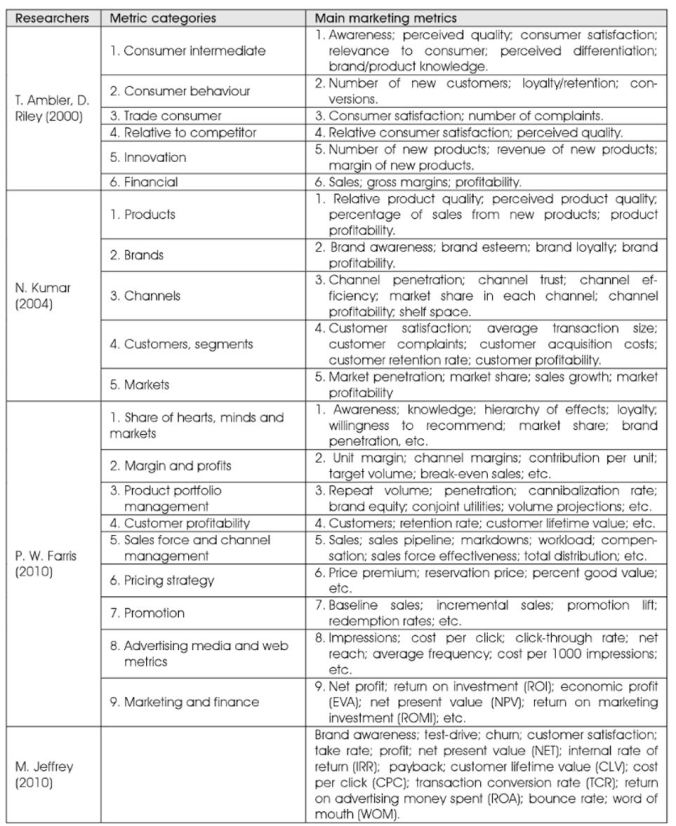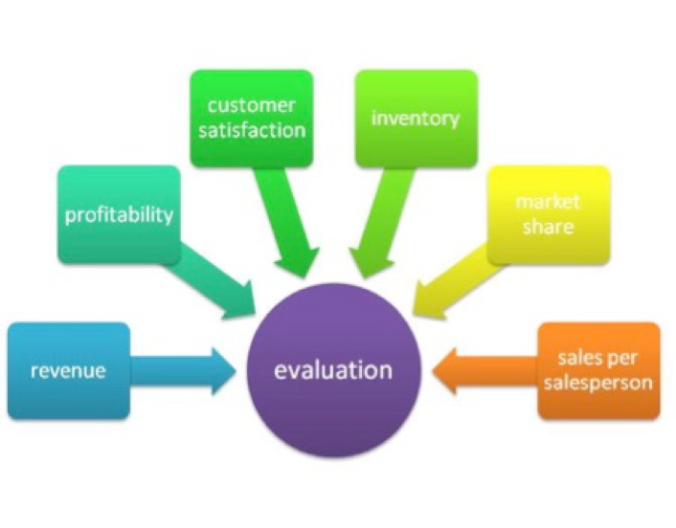Marketing Metrics
The use of marketing metrics has increased tremendously, which makes it an important instrument to measure marketing performances. Marketing metrics permit companies to justify their investment in their marketing strategy, and to predict the financial impacts and difficulties (Vianello cited in Cohard et al. 2014). In order for a company to increase their value, they need to measure and evaluate their performance through marketing metrics.

Figure 1:Performance measurement (Tescasia 2015)
The figure above illiterates what marketing metrics hopes to achieve:an increase in profits due to an evaluation and adaptation of ones marketing mix to meet customer needs.
Many researchers have attempted to define what metrics categories and marketing metrics are used together, which are summarized in the image below:

Table 1: Metrics categorized by competent researchers (Salkovka cited in Cohard et al. 2014)
Cohard et al. (2014) found that the most commonly used marketing metrics in companies are actually non-financial, such as market share, customer satisfaction, customer loyalty/retention, brand equity and innovation. All of these aspects are important; however, electronic commerce has impacted how marketers may measure metrics. An increased number of customers are spending more time shopping for books, music, appliances, airline tickets and groceries online, which has made the Internet a commodity for many. The U.S. Census Bureau announced that the 2016 second quarter retail e-commerce sales was $97.3 billion, which means that there is a great opportunity for companies to excel online. Therefore, marketers need to not only measure traditional metrics, but online metrics as well. The good news is that there is a whole career path dedicated to studying and interpreting online metrics; so, we actually have marketers who specialise in this field.
DeMers (2014) states that there multiple Online marketing metrics that are important for companies to measure. Some of these include:
Total Visits
he total amount of visits on a company’s main website should be the primary target for current customers and potential customers. The measurement of the total number of visits will allow the company to see how well their advertising campaign is going. If the number of visits declines from month to month this will give you a chance to do an investigation and potentially fix the problem. Generally, if the marketing campaign is steady the number of visitors are expected to grow steadily.(See illustration in figure 2 below) .

Figure 2:Google Analytics example:(Busnessbee n.d)
New visits
This is a metric found in Google Analytics that lets you know the total number of new visits on your company’s site as well as the number of repetitive visitors. This is great metric as it will show you if your site is attractive enough to encourage repeat customers and also shows how effective the campaign outreach efforts are. If for example you change the content or structure of your website and this ratio significantly drops then you know this particular campaign it not working and adjust it.(See figure 2 above)
Channel-Specific Traffic
A company’s channel-specific metrics can be found in the “Acquisition” section of Google Analytics. The companies traffic will be based on their point of origin by the company’s channel-specific metrics. This is very useful as just the total visits number cannot give an indication of which channel is used the most frequently. Within channel-specific traffic there are four main variables, including:
1.Direct – the number of people who visited the site directly.
2.Referrals– the number of external links from other websites.
3.Organic– site visitors who found the site by searching.
4.Social– the number of people who found the site though social media.
Bounce Rate
This is the total percentage of people who leave the site before further clicking on anything on the webpage. It is preferred for this to be low as you would want people to stay on your site for longer so that they can be more likely to take action on it.
Lead to Close Ratio
This measures sales success and shows the context of the company’s total return on investment. This metric is found by dividing the total number of the firm’s sales by the total number of its leads.
Customer Retention Ratio
This can be difficult to measure if your company sells one-time only products but things such as subscription based services enables businesses to easily measure retention. Customer retention can be calculated by simply calculating the percentage of return customers.
It is important for a company to regularly check the above mentioned metrics as well. Overtime the advertising campaign and sites can be adapted accordingly to the best working strategies to allow a stable marketing rhythm that will generate optimal profits.

Figure 3:Illustration of online metrics
Reference List
Tescasiu, B 2015, Considerations upon ‘marketing metrics’, Bulletin of the Transilvania University of Braşov, vol. 8, Economic Science, Business Source Complete.
https://www.census.gov/retail/mrts/www/data/pdf/ec_current.pdf
Mavis Maravanyika
mavis1306-216041785

















